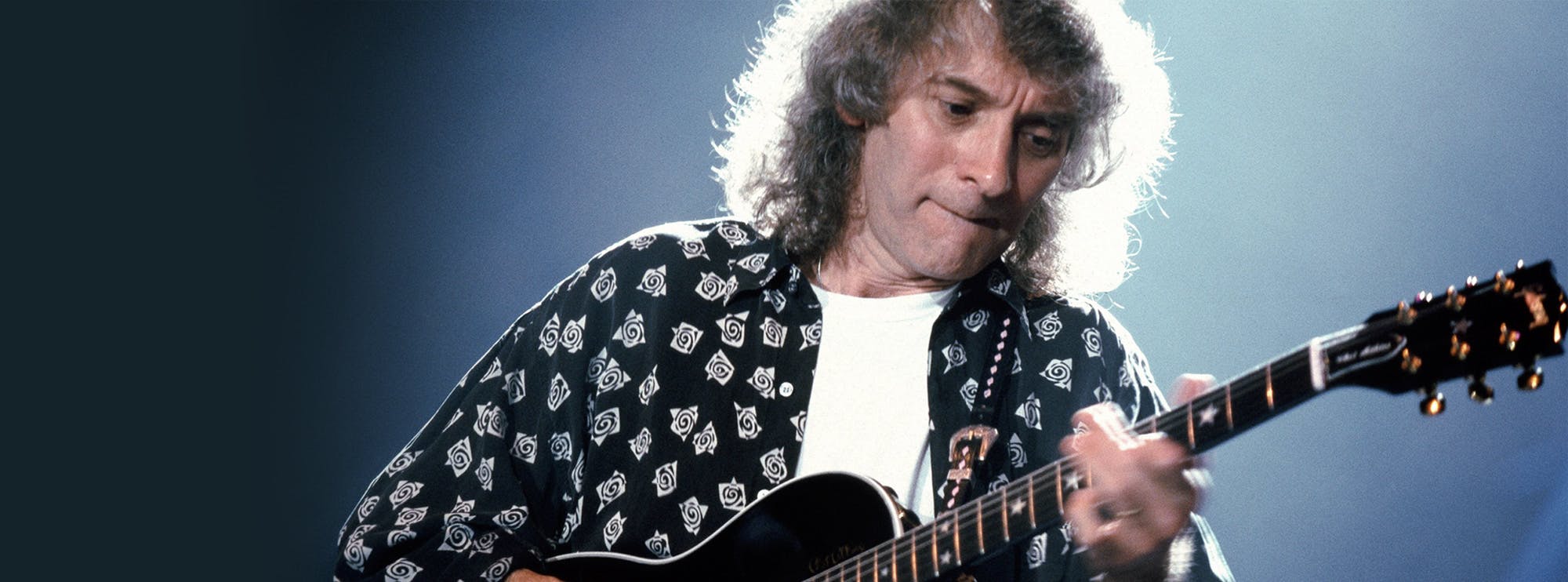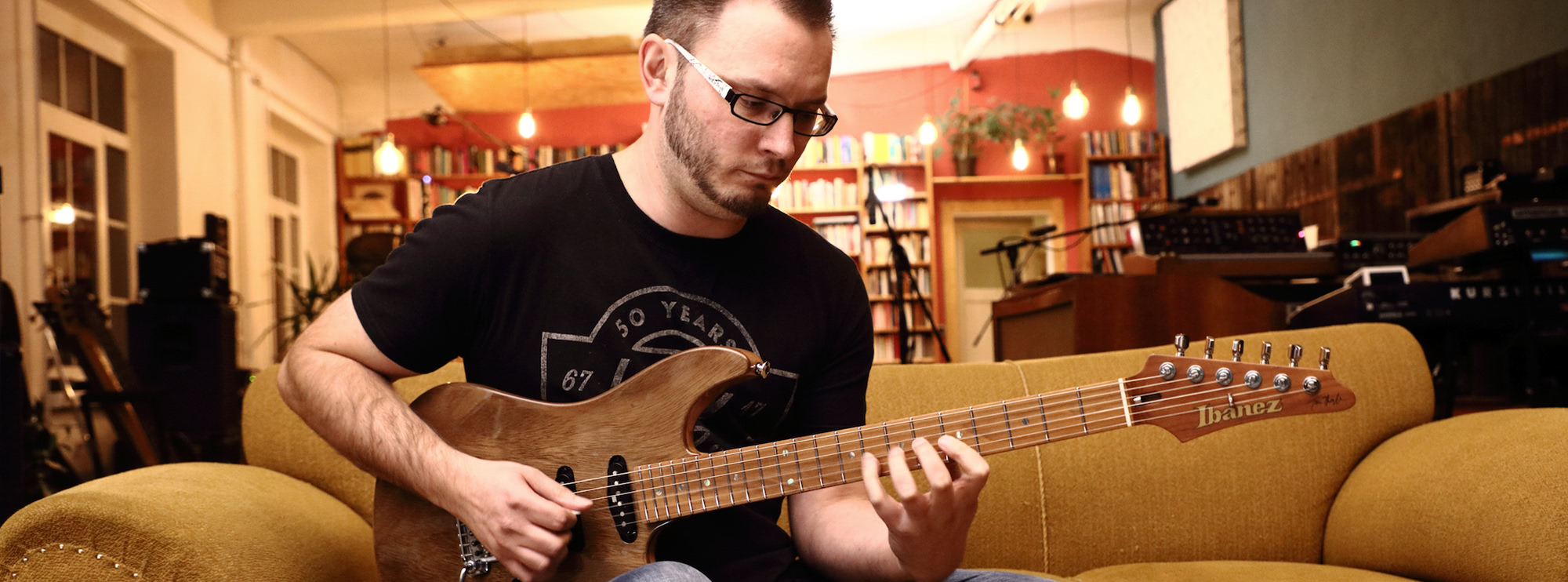Over the years I've written a lot about David Gilmour and Pink Floyd. In fact the first ever issue of Guitar Interactive Magazine featured a full Gilmour issue where I examined several different aspects of his playing, from rhythm to lead, old to modern (Sadly, GI Issue One was lost due to technical problems, see this issue's editorial for more! Ed). I have also produced several DVDs under the Lick Library banner! When our editor approached me about composing and writing another piece on Gilmour, at first my thoughts were 'What else can I do? I've looked at Gilmour style in depth!' But then I looked at this piece from a different angle, and as opposed to looking at Gilmour in context of Floyd, I have chosen to look at Gilmour as a solo artist; although there is some Floyd inspiration in there!
David Gilmour has released four solo albums, the self titled “David Gilmour”, 1978’ “About Face”, 1984, “On An Island”, 2006, and “Rattle That Lock”, 2015. The albums cover a wide variety of styles, as well as Gilmour collaborating with artist as diverse as David Crosby, Graham Nash, Jools Holland, Mica Paris and Pete Townsend!
Although Gilmour’s playing style has its feet firmly planted in Blues, his musical composing style crosses over into the progressive/art rock genre, with his compositions featuring extended arrangements and multiple time signatures.
Jamie Humphries
Gilmour has also collaborated with artists as diverse as Bryan Ferry, performing on his album “Boys and Girls”, and The Orb, who called on Gilmour for his ethereal sonic skills for the album “Metallic Spheres”. 2014 and saw the release of the final Pink Floyd album, “The Endless River”, which was largely an ambient instrumental album.
Although Gilmour’s playing style has its feet firmly planted in Blues, his musical composing style crosses over into the progressive/art rock genre, with his compositions featuring extended arrangements and multiple time signatures. His playing style is mainly based around pentatonic and Blues scales, and features long sustaining melodies, slow melodic arpeggios, and a subtle whammy bar vibrato. One of his signature techniques is his use of string bends, often bending notes as far as two whole tones. His bending style was a direct influence from listening to Albert King. Bars 3-4:
Include a classic Gilmour chord figure based around the A7 chord. This chord is embellished with the shifting minor 7th and major 6th shapes, performed on the 2nd and 4th strings, with the 3rd string allowed to ring out. This section concludes with the Cmaj7/G to B7 chord. Again these chords feature a fairly sparse rhythm and are embellished with arpeggio techniques.
Bars 5-8:
Repeat the previous four bars, with a few rhythmic and performance variations. With this verse section really try to be dynamic, and laid back with the performance, and try to sit back on the beat.
Bars 9-11:
Features a bridge section including the bare chords of E minor, B minor, A major and G major. This section concludes with the altered chord of B7#9 shifting to B7b9, before resolving to the Emadd9 chord. Also pay attention to the shift in time signature, 12/8 bar to 6/8 bar and back to 12/8 bar.
Bars 12-13:
Kick the solo off over a new section, with the accompanying chords of Em11 and Am. I have given the “Shine On” chord a huge nod on the backing track, by performing it a tone higher than normal, with a capo at the second fret, helping with the Floydian vibe. The solo kicks off with the B minor pentatonic over the Em11 chord, which is a technique often used by Gilmour. You can add a fresh sound to your pentatonic soloing by simply using a pentatonic scale a 5th above the chord you're playing over. This technique outlines the 2nd or 9th, adding a modal sound without you needing to know any new scales! We shift back to the E minor pentatonic over the A minor chord, which again uses the 5th above technique.
Bars 14-15:
Kick off with an extended E minor arpeggio that is embellished with whammy bar slurring. This is an extended arpeggio that covers a wide portion of the neck, so take care with the position shifts. We then introduce the new chord, C/F, aiding an F Lydian sound, which is outlined with a climbing series of string bends.
Bars 16-18:
Features some classic Gilmour bluesy based licks, as well as a whopping two tone bend! Really pay attention to the pitch of the bends and the feel of this section, as we mix searing bends with fluid lines.
Bars 19-21:
Conclude with a descending bending figure that follows the “Shine On” inspired chords of F major, C/E, D minor, Dm/C to B7. We outline the B7 chord with an arpeggio that isn't used that often by Gilmour, the B dominant 7th arpeggio, but I've performed it in a Gilmour-esque way to show how you can add flavours of his playing to other techniques and approaches. We conclude with bends that outline the chords of E7#9 to E7b9 before concluding the solo over the final.
About The Tutor
Tutor Profile
Jamie Humphries
Jamie is one of the mainstays of LickLibrary, having a stream of hugely successful best selling DVDs, Jamie is best known as Brian May's sideman who he's played shows with all over the world. Aside from this Jamie is a hugely popular clinician working all over the world with Ernie...



